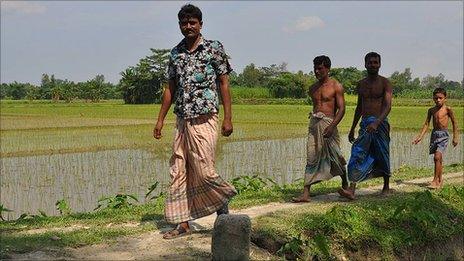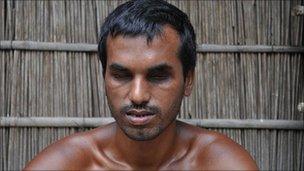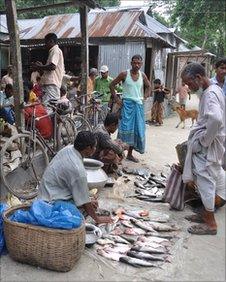Stateless misery on India-Bangladesh border
- Published

Enclave residents complain they are in limbo - unwanted by India or Bangladesh
Thirteen years ago Saifur Rahman had a severe injury to his eyes and was taken to a hospital in northern Bangladesh.
But doctors refused to treat him, saying he was a foreigner.
It came as a rude shock to the 35-year-old farmer from the village of Kalirhat in the district of Kurigram, which borders India.
For people like Mr Rahman, Bangladesh has been home. He was born and brought up in Bangladesh, although officially he and his fellow villagers are Indian citizens.
"I lost my eyesight because I did not get treatment in time. I couldn't go across the Indian border as I had no valid documents to prove my identity," says Mr Rahman, who is among the 7,000 people living in the Indian enclave of Dosiarchaura, a few kilometres from the border inside Bangladesh.
Officially this area is part of the district of Cooch Behar in the Indian state of West Bengal.
'No papers'
Dosiarchaura is among more than a 100 Indian enclaves inside Bangladesh. The border has never been properly demarcated.

Saifur Rahman lost his eyesight because of his statelessness
The Indian enclaves are like territorial islands which belong to India but are surrounded completely by Bangladesh.
Similarly, there are more than 50 Bangladeshi enclaves inside India.
Most of these land-locked enclaves are situated close to the border between the two countries and many outsiders do not realise they even exist.
Yet the fact remains that people living in Indian enclaves inside Bangladesh are officially Indian citizens and those living in Bangladeshi areas inside India are Bangladeshis.
"We have no papers to prove that we are Indians and Bangladesh doesn't consider us as their citizens. We have been in a state of limbo for decades," says Mr Rahman, who is married with two sons.
Nestled between paddy fields, ponds and lush green bamboo, the enclaves appear similar and it's not obvious where the international border is.
Common to all the enclaves is abject poverty, with no signs of any civic amenities. The residents are effectively stateless.
Arguments and treaties
"There is no school here, no hospital, no roads and no electricity. If there is any violence, there are no police. Nobody comes from Bangladesh or from India to help solve our disputes," says Roshanara Begum, the wife of Mr Rahman.
"My sons go to school in Bangladesh but they have to use fake identities for their admission. We feel completely abandoned by both countries."
Folklore says the patchwork of enclaves resulted from a chess game between the Maharajah of Cooch Behar and the Nawab of Rangpur, two minor kingdoms that faced each other until just after independence from British rule in 1947.
The two rulers used villages as wagers and wrote the names of the villages on a small piece of paper - or chit - and exchanged them whenever they won or lost a game. Locals say that is why these enclaves are called "chit mahals" or "paper palaces".
Historians say the enclaves have been here for centuries - the product of arguments and treaties between successive local rulers.
The enclave issue was not resolved during the turmoil of the 1947 partition of the subcontinent when India and Pakistan were carved out of British India.
Cooch Behar was designated to India and Rangpur went to Pakistan, including the people who lived on the "chit mahals".
Community spirit
Neither was the enclave issue resolved when East Pakistan became Bangladesh in 1971 following the war of independence.

Enclave residents have no state support form either India or Bangladesh
Four decades later it still lingers - bad news for the estimated 51,000 people living in enclaves on both sides of the border.
Yet despite the hardships, there is a strong community spirit in Dosiarchaura. Muslims and Hindus live side by side and frequently support each other.
Products sold in the village market come from neighbouring towns and villages in Bangladesh. Products manufactured in the Indian enclaves, like wooden cabinets or farm tools, are sold in Bangladesh.
The Indian residents of this enclave use the Bangladeshi taka as their currency. People here work as farm labourers, although some work in Bangladesh as rickshaw pullers.
Officially, they are not supposed to be working in Bangladesh but the practice has gone on for decades.
'Pathetic outcome'
Despite being Indian nationals, the residents of this enclave say that Delhi wants nothing to do with them.
"My nephew went to Delhi for work a few years ago. He didn't have any identity card, so the police there arrested him. He was given a three-year jail sentence for trespassing from Bangladesh," says 40-year-old Aarthi Bhalla, a farm labourer.
"It was a pathetic outcome - India treats us like illegal immigrants, they don't realise this enclave is part of India."
India and Bangladesh are holding talks to find a long-term solution to the enclave problem. The two countries may reach an initial agreement for a land swap when Indian Prime Minister Manmohan Singh visits Dhaka this week.
One idea is for them to exchange the parcels of land - like Dosiarchaura - inside each other's territory. Officials are also talking about giving an option allowing people to choose where they want to live - either in India or Bangladesh.
Such a deal may invite criticism from hardliners in both countries. However both seem to realise it is not in their interests for the status quo to continue.
As politicians plan their next move, the people here remain in limbo. They know they are just pawns in a bigger political game.
- Published14 July 2011